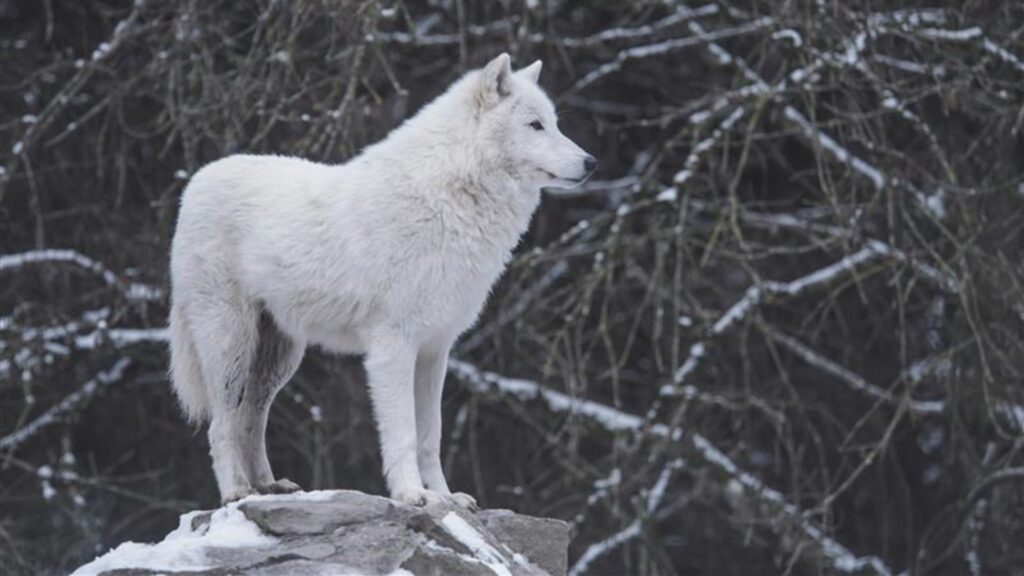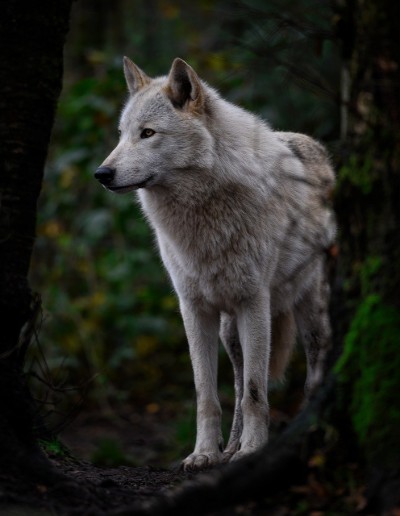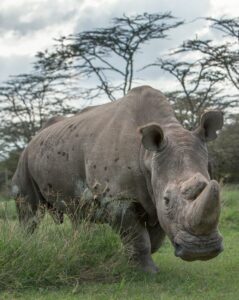Can an animal be brought back from extinction?
The claimed ‘de-extinction’ of dire wolves using ancient DNA appears to offer hope. But, is it what it seems, and should we focus on saving the species we still have?

A white wolf (c) Unsplash
An American biotech company has posted a video inviting you to ‘meet Romulus and Remus – the world’s first de-extinct animals’. Claiming you can hear the ‘first howl of a dire wolf in over 10,000 years’, the video apparently had 13 million views in under 24 hours.
Famously portrayed in TV fantasy drama Game of Thrones, the dire wolf was once native to the Americas. With a vast range from Canada to Venezuela, the ancient wolf went extinct at the end of the last ice age.
Can you really bring a species back from extinction? Should you spend billions even trying? Could de-extinction be critical for conservation, or, are Romulus and Remus actually ‘designer dogs’?
To find out more, Born Free spoke to two globally-acclaimed experts, veterinarian Dr Mark Jones, our Head of Policy, and biodiversity scientist Dr Nikki Tagg, our Head of Conservation. What do they think about the dire wolf claims, and the expensive process of trying to bring long-lost species back from the dead?
The world’s wildlife is in crisis, with more than a million species thought to be threatened with extinction, primarily due to human activities.

Dr Mark Jones and Dr Nikki Tagg (c) George Leakey
Texas-based ‘billion-dollar start-up’ biotech company Colossal Biosciences says that the solution lies in what it terms ‘de-extinction’ – using gene-editing technology to rebuild the DNA of lost megafauna and other creatures.
The company recently claimed it has created three dire wolf pups (Canis dirus) by splicing ancient genes from fossilised remains into grey wolf DNA. In addition to dire wolves, they have plans to ‘de-extinct’ woolly mammoths, dodos, thylacenes (Tasmanian tigers) and other lost species.
Meet the dire wolf
Packs of dire wolves roamed across the grasslands and forests of North America for millennia, until they disappeared around 10,000 years ago. They were impressive animals, standing at over a metre tall at the shoulder and weighing as much as 70kg.
They are thought to have preyed on large mammals such as bison, horses, and mastadons (prehistoric elephants). Their extinction was likely the result of a changing climate and the loss of key prey species. Modern wolves evolved separately from a different lineage and were better able to adapt to the changing environment.
People have long been fascinated by dire wolves. They are often depicted as mythical creatures, in fantasy productions such as the American drama, Game of Thrones. The female pup created by Colossal Biosciences has been named Khaleesi, after a character from this show. George R.R. Martin, author of the books Game of Thrones was based on, has even been photographed holding the wolf pups, further begging the question whether their attempted de-extinction reflects the needs of science or of fantasy.
As a result, many are questioning the ethics of these de-extinction claims, their relevance to modern-day conservation challenges, and even the validity of the claims themselves.
When is a wolf a wolf?

A grey wolf (c) Angela from Pixabay
Scientists responding to the news have pointed out that the three wolf pups – Khaleesi and two males, named Romulus and Remus – are not actually dire wolves at all. Rather they are genetically modified grey wolves with some traits such as larger skulls and white fur that are reminiscent of dire wolves.
Colossal Biosciences researchers used DNA obtained from fossilised remains of dire wolves – a tooth and an inner ear bone – to partially map the dire wolf genome. They then selected grey wolves as dire wolves’ closest living relatives and edited 20 of their genes to express dire wolf ‘phenotypes’ (how an animal looks and behaves).
However, an extinct animal cannot be resurrected according to the International Union for the Conservation of Nature (IUCN). ‘None of the current pathways will result in a faithful replica of any extinct species, due to genetic, epigenetic, behavioural, physiological, and other differences’.
So, rather than bringing back an extinct species, Colossal Biosciences have created something new, at best a ‘proxy of an extinct species’, as purported by IUCN, or what some critics have hailed ‘a designer dog’.
Elephant in the room
Colossal Biosciences allude to the environmental benefits of its work, claiming that ‘de-extinction is critical for conservation’. However, it’s not at all clear what the purpose of creating bigger, stronger, white-furred wolves would be, from a conservation perspective.
Our ‘extant’ (still in existence) wolves are struggling to survive in a human-dominated world. Having suffered persecution at the hands of people for centuries, they are now having to cope with additional pressures such as loss of prey and climate change.
Years of protection across much of Europe has resulted in a fragile recovery of grey wolf populations. But, heartbreakingly, their protected status is currently being downgraded to make it easier for farmers and authorities to kill them when they are believed to become a nuisance.
In areas of the United States where wolves have made a comeback, they are being hunted and killed by farmers and ranchers, particularly where they are seen as a threat to livestock. Some US States have implemented controversial policies allowing wolf hunting and trapping.
Given these circumstances, it’s hard to see how an even bigger and more powerful species of wolf might be tolerated if they were to be released. Colossal Biosciences evidently have no plans to release their wolves, thus further questioning their conservation claims.
Mammoths vs elephants
The same could be said about woolly mammoths, another species that Colossal Biosciences has plans to ‘de-extinct’. This ancient species once roamed grassland steppes of Eurasia and North America in their millions. But they fell into to decline following the end of the last ice age when their habitats began to shrink with the warming climate.
The last woolly mammoths died out around 4,000 years ago. As part of a claim that the ecosystem services provided by now extinct species could help transform and re-create important habitats, it’s argued that restoring tundra could assist us today in our fight against climate change. Grasses and shrubs are excellent at soaking up carbon monoxide.
However, the world has changed dramatically since the time of woolly mammoths, and the ecological niche they once inhabited no longer exists. As the world rapidly warms up once again, thanks to human-induced climate change, it’s difficult to envisage a habitat that could effectively support a self-sustaining woolly mammoth population. Similarly, bringing back the woolly mammoth would not lead to the re-establishment of these lost grasslands.
Present-day elephants, however, are proven ecosystem engineers. Their presence increases the carbon-holding potential of forests. We are struggling to protect the fast-declining populations of elephants that remain across Asia and Africa, due to poaching, conflict and habitat loss.
Save one wolf, demonise another
Similarly, what could be the justification for attempting to bring back an extinct wolf species, while we relentlessly drive existing wolf species towards extinction? If existing habitats can’t effectively support many of the species we currently have in the face of human activities, the chances of it being able to support genetically engineered copies of long-lost species seem at best extremely remote.
From a conservation and environmental perspective, we should instead be doing all we can to prevent the extinction of our present-day elephants and other large mammals.
A further concern is the risk that engaging the media through these dramatic and wondrous ‘de-extinction’ events could lead to a loss of public interest in protecting existing species. There may also be a misguided perception that perhaps we need not worry because we can always ‘de-extinct’ these animals later.
A new welfare worry
One concern that seems to evade the current debate, is that of the welfare of the de-extincted individuals. Dire wolves and woolly mammoths were intelligent and social animals, as are the grey wolves and African elephants being used as surrogate mothers for these genetically modified animals.
We simply do not know what level of confusion, pain or suffering could be borne by the individual animals created through this technology. Or whether the offspring – suddenly so different to others around them – would be accepted and able to survive. More likely they would become another captive curiosity in zoos and animal parks.
A façade to develop new technology

Sudan, the last male northern white rhino (c) www.georgelogan.co.uk
The advances in biotechnology that lie behind these ‘de-extinction’ techniques are certainly impressive. Such techniques could potentially be used to try to recover species or subspecies that are on the very brink of rapid human-caused extinction.
Only two female northern white rhinos remain, under constant guard at the Ol Pejeta conservancy in central Kenya. The decline of the northern whites resulted from intensive poaching, loss of habitat, and genetic bottlenecking. There are efforts to restore the species, that revolve around the creation of northern white rhino embryos in a lab. Then using closely related southern white rhinos as surrogate mothers – resembling the embryo transplant techniques increasingly used in humans.
However, in this case, it’s difficult to see how the genetic variability that is so important to enable species to survive and evolve can be recreated from such a small pool of embryos. Even if it were possible to clone these last two living southern white rhinos, with such a restricted gene pool, the species would be ‘functionally extinct’ (when a species still exists but is unable to play any role in the ecosystem, due to population decline or disruption in their gene flow).
A more effective solution from a conservation perspective could be to introduce southern white rhinos into suitable landscapes previously occupied by their northern cousins.
Extreme reactions to preventing extinction
Some believe that taking endangered wild animals into captivity and breeding them for release is the answer to preventing extinctions. However, very few species have been successfully reintroduced into the wild from captive populations.
Wild animals are often difficult to breed in captivity. Captive-bred animals may not adapt well to life back in the wild. And, all-too-often, we haven’t been able to reverse the reasons why the species become endangered in the first place, so reintroduced animals from captive bred populations end up facing the same threats.
‘Lonesome George’, the last known Pinta Island giant tortoise, was discovered and brought into captivity in 1971. He was kept in an enclosure on Santa Cruz island in the Galapagos for 40 years, and introduced to many females from closely related species, but failed to breed.
George died in 2012, at around 100 years old, marking the passing of the last of his species. His death was mourned as a symbol of the irreversible loss caused by human activity. Particularly the destruction of habitats, overhunting, and the introduction of non-native invasive species to the Galapagos islands.
The real problem
In its efforts to measure the plight of wildlife across the world, the IUCN has to date assessed the conservation status of roughly 170,000 species for its ‘Red List of Threatened Species’. Of these, around 50,000 are considered to be ‘threatened with extinction’, with more than 10,000 categorised as ‘Critically Endangered’ and facing an extremely high risk of extinction in the wild.
The Critically Endangered category includes over 4,000 animal species, and features charismatic mammals such as African forest elephants, Javan and Sumatran rhinos, Atlantic humpback dolphins, North Atlantic right whales, and all three species of orangutans, among many others.
In their Global Assessment of Biodiversity and Ecosystem Services published in 2019, esteemed scientists from around the world estimated that the true number of threatened species could exceed a million. They concluded that human activities, in particular changes in land and sea use, direct exploitation of organisms, climate change, pollution, and invasive alien species, were to blame.
They went on to recommend that transformative changes are needed to restore and protect nature. The scientists are embarking on a further assessment which should be published in 2028. The results are expected to show further declines.
If we are to halt and reverse the devastating declines in nature that we’re currently seeing, we need to fundamentally change our relationship with wildlife. The billions currently being invested in the fanciful and futuristic creation of copies of long-post species by the likes of Colossal Biosciences would surely be better spend protecting the species we currently have and incentivising and enabling people to coexist alongside nature and wildlife.
Genetically engineered animals, or captive breeding programmes, won’t provide the solution to the crisis facing nature and wildlife – they are fantasy. Those solutions lie primarily with our own behaviour.

SUPPORT BORN FREE TODAY
Every year, Born Free rescues, campaigns for and protects thousands of wild animals around the world. With your support we can continue to work tirelessly to ensure that all wild animals, whether living in captivity or in the wild, are treated with compassion and respect and are able to live their lives according to their needs.
